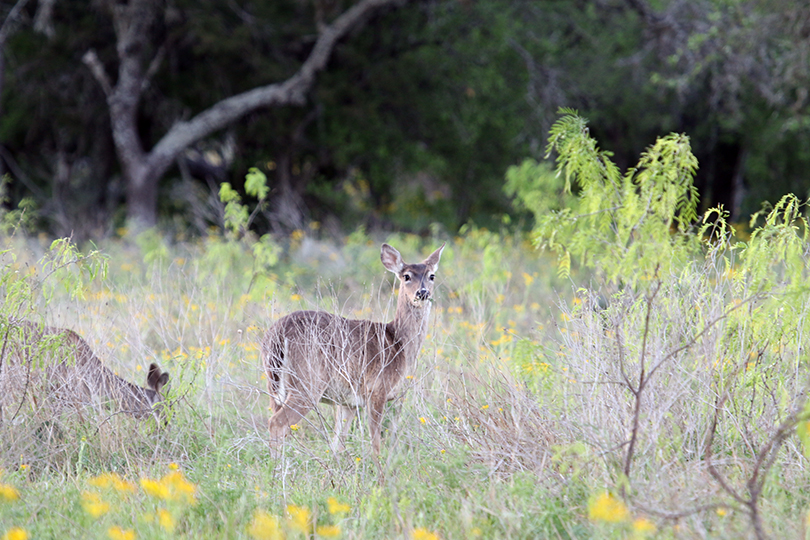By Jennifer Whitlock
Field Editor
In response to a recent surge in identified cases of chronic wasting disease (CWD) among captive-bred and wild deer populations, the Texas Parks and Wildlife Commission recently unanimously approved the creation of new CWD containment and surveillance zones and expanded others.
The new zones are necessary to help stop the spread of CWD, Texas Parks and Wildlife Department (TPWD) Big Game Program Director Mitch Lockwood testified at the commission’s August meeting.
“CWD was detected in an 8-and-a-half-year-old mule deer buck on the east side of Lubbock last February. This was a free-ranging deer that was exhibiting clinical symptoms indicating that it likely had the disease for a couple of years or so,” Lockwood said. “Despite a fairly aggressive surveillance program in this area of the state for the past six years, more intensive sampling in the immediate area where the CWD positive deer was located is necessary to begin to get an understanding of the geographic extent and the prevalence of the disease.”
Much remains a mystery when it comes to CWD, TPWD wrote in a proposal to the commission asking for the zone changes. Intraspecies transmission, infection rate, incubation periods and if CWD can be transmitted to other species are still being studied in Texas and around the U.S.
What is known, TPWD said, is that CWD is fatal to most cervids and is transmitted both directly and indirectly.
“If CWD is not contained and controlled, the implications of the disease for Texas and its multi-billion-dollar ranching, hunting, wildlife management and real estate economies could be significant,” the department stated.
Now, a new containment zone will cover a 75-square-mile radius in Lubbock County, while a larger 700-square-mile surveillance zone will encompass portions of Lynn, Lubbock, Crosby and Garza counties. No other CWD-positive wild or captive-bred deer have been found in the area, according to TPWD data.
Another new surveillance zone was approved for areas of Hunt, Rockwall, Kaufman and Van Zandt counties.
Lockwood noted CWD was detected in a deer-breeding facility located on the border of Hunt and Kaufman counties known to have released deer to an adjoining release site over the past few years. Establishing a surveillance zone will allow TPWD to “provide some confidence” the disease has not migrated to the free-ranging deer population in the area, he said.
The commission also approved expansion of CWD zones in Uvalde County, a hot spot for recent CWD-positive discoveries. CWD has been detected at three separate breeding facilities on two premises located about 25 miles east of existing South Texas CWD zones. Lockwood asked the commission to expand the current surveillance zone to include the properties.
“Over the past six years, more than 12,000 samples collected within a 50-mile radius of the Uvalde County index facility were tested for CWD,” Lockwood said. “The majority of those deer were harvested in our existing zones, providing strong evidence that the disease is not yet established in the native population there. However, additional surveillance to the west would give us a better idea if that’s the case over there, as well.”
Carcass movement restrictions, mandatory testing of hunter-harvested deer and restrictions on the movement of live deer will be in effect in these new zones as for all currently-existing containment and surveillance zones in the state.
The Texas Wildlife Association (TWA) is in favor of the new zones.
TWA CEO David Yeates told the commission there is a perceived lack of surveillance outside of deer breeders but increasing the zones and upping enforcement will be beneficial in detecting the true spread of CWD since it was first identified in Texas in 2012.
“It’s not lost on me that manning check stations and collecting roadkill tissue samples is not as fun as guiding youth hunts or working with landowners on habitat management. But it’s really important work, and we’re very thankful for TPWD’s focus and dedication of resources,” Yeates said. “I’ve seen some human dimension studies that show most hunters are woefully uninformed on CWD. So, anything that can be done to make this intuitive and simpler, we’re absolutely in support of, and I encourage the commission and TPWD to be thinking that way.”
TPWD must file the adoption preamble in the Texas Register. Then, the new rules will take effect 20 days after that.


How does the containment zone affect hunters of free-range deer. What should sportsman be looking for to determine if a deer is affected.